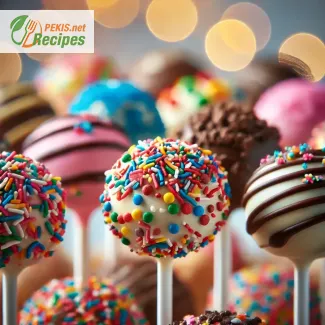
Irresistibly Smooth and Sweet: The Ultimate Vanilla Buttercream Guide
Why every baker needs a go-to buttercream frosting
In the world of baking, few things are as universally loved and endlessly versatile as buttercream frosting. Whether you're frosting a birthday cake, filling a stack of macarons, or simply spreading a swirl over cupcakes, a silky-smooth vanilla buttercream is the gold standard of classic confections. This decadent, fluffy frosting is not only a staple in professional kitchens but also a beloved choice for home bakers around the world.
What sets this particular buttercream frosting recipe apart is its balance of creamy texture, sweet vanilla aroma, and a consistency that’s easy to work with whether you're piping roses or coating a multi-layered cake. It embodies everything a good buttercream should be—light, airy, buttery, and rich, yet never overly sweet or greasy. With just a few high-quality ingredients and the right technique, you can achieve a bakery-worthy finish at home.
The classic charm of vanilla buttercream
There’s something timeless about classic vanilla buttercream. Its pale ivory hue, subtle sweetness, and indulgent creaminess make it a favorite for decorating everything from wedding cakes to sugar cookies. The smooth and spreadable texture ensures that every bite melts in your mouth while allowing the flavors of the cake underneath to shine through.
Choosing the right vanilla extract is essential. Pure vanilla extract, or even better, vanilla bean paste, will elevate your frosting with a rich, aromatic complexity. Combined with unsalted butter whipped to perfection and powdered sugar that adds structure and sweetness, this frosting is a reliable canvas for both flavor and creativity.
Customizing buttercream for every occasion
One of the reasons this buttercream frosting is so essential in any baker’s repertoire is its adaptability. By using this basic vanilla base, you can create a multitude of variations:
- Chocolate buttercream: Add melted dark chocolate or cocoa powder.
- Citrus twist: Incorporate lemon or orange zest for a zesty version.
- Spiced frosting: Add cinnamon, nutmeg, or chai spices for warmth.
- Fruit-flavored buttercream: Blend in pureed raspberries or strawberries for a natural tint and fruity flair.
No matter the flavor, this frosting recipe provides the ideal starting point, ensuring consistency and ease of preparation while still leaving room for personalization.
Perfect pairing for every dessert
The versatility of buttercream frosting is unmatched. Pair it with a moist vanilla sponge, layer it between rich chocolate cake rounds, or use it to top fluffy red velvet cupcakes. Its ability to hold shape makes it ideal for detailed piping work, while its taste ensures that the visual appeal is matched by satisfying flavor.
Home bakers and professionals alike value this classic frosting not just for its taste but also for its performance. It stays stable at room temperature, can be made in advance, and is easy to rewhip if refrigerated. Whether you're preparing a simple dessert for family or a show-stopping cake for a celebration, this buttercream will never let you down.
Texture, taste, and technique in perfect harmony
The key to achieving the perfect buttercream frosting lies in attention to detail during the preparation. Softened butter must be beaten long enough to incorporate air and create that light, fluffy base. Gradually adding powdered sugar prevents grittiness and ensures smoothness. A dash of heavy cream or milk allows you to control the consistency, whether you need a firmer texture for piping or a silkier spread for covering layers.
Beyond just a sweet topping, this vanilla buttercream transforms a basic dessert into something truly special. Its luxurious texture and elegant flavor profile make it a reliable choice for both everyday baking and extraordinary events.
Why homemade buttercream makes all the difference
While store-bought frostings can be convenient, they often contain preservatives, artificial flavors, and an overly sweet aftertaste. Making your own buttercream frosting from scratch allows you to control every ingredient, ensuring a fresher, more flavorful result. Plus, once you've mastered the technique, the process is quick, rewarding, and easily adjustable to suit your preferences.
This homemade buttercream frosting recipe is the foundation for countless dessert possibilities. With its rich vanilla flavor and pillowy texture, it not only enhances the look of your baked goods but elevates the entire eating experience. Whether you're new to baking or a seasoned pro, this is one recipe you'll return to again and again.
1. Prepare the butter:
Take the unsalted butter out of the fridge and allow it to soften at room temperature for at least 30–60 minutes. The butter should be pliable but not melted. Place it in a large mixing bowl.
2. Whip the butter:
Using a stand mixer or handheld electric mixer, beat the butter on medium-high speed for 5–7 minutes. It should become pale, fluffy, and creamy. This step is essential for achieving a smooth, light texture.
3. Add the sugar gradually:
Sift the powdered sugar to avoid lumps. Gradually add it to the butter, 50–100 g (½ cup) at a time, beating well after each addition. Scrape down the sides of the bowl frequently. Once all the sugar is incorporated, beat the mixture on high speed for another 2 minutes.
4. Incorporate vanilla and milk:
Add the pure vanilla extract and milk or cream. Beat again for 2–3 minutes, until the buttercream is silky and spreadable. If needed, adjust the consistency by adding 1 tsp of milk at a time for a looser texture or a few tablespoons of powdered sugar to thicken.
5. Season and smooth:
Add fine salt to enhance the flavor. Mix thoroughly for an additional 30 seconds. The buttercream is now ready to use for piping, spreading, or layering.
Elevating Your Buttercream Game: Tips for a Flawless Frosting Finish
Discover how to perfect and personalize your buttercream for every occasion
Mastering the art of buttercream frosting goes far beyond simply mixing butter and sugar. While the classic vanilla buttercream recipe is a tried-and-true staple in many kitchens, there are countless ways to refine, enhance, and tailor it to different tastes, dietary needs, and presentation goals. From experimenting with alternative ingredients to adjusting the texture and flavor for different climates and occasions, understanding how to elevate traditional buttercream can transform a good dessert into a truly unforgettable one.
Selecting the best ingredients for superior taste and texture
The foundation of any great buttercream frosting is high-quality ingredients. Using unsalted European-style butter with a higher fat content (usually around 82%) can make a noticeable difference in richness and mouthfeel. Compared to standard butter, it creates a smoother, creamier texture with a more luxurious finish.
When it comes to vanilla extract, the type you use truly matters. Pure vanilla extract or vanilla bean paste offers a far deeper and more nuanced flavor than artificial vanilla. If you want a more complex and aromatic profile, consider using Madagascar bourbon vanilla, which imparts warmth and subtle caramel notes.
Even the powdered sugar plays a role in texture. Some commercial varieties include anti-caking agents that can cause a slightly gritty finish. Opting for a finely milled, additive-free sugar will result in a smoother consistency.
Flavor variations that enhance and diversify
The beauty of buttercream lies in its adaptability. With just a few thoughtful additions or substitutions, you can take your vanilla base and turn it into a wide range of flavor profiles without sacrificing its signature fluffiness.
- Salted caramel buttercream: Add 2–3 tablespoons of cooled homemade caramel for a rich, deep sweetness.
- Citrus zest and juice: Lemon or orange zest adds brightness and cuts the sweetness. Use zest for flavor without thinning the texture.
- Spiced buttercream: Add a pinch of cinnamon, nutmeg, or cardamom for a warm, spiced twist perfect for autumn or holiday desserts.
- Espresso buttercream: A teaspoon of instant espresso powder intensifies chocolate desserts and adds sophistication.
Each addition changes not only the flavor but also the balance of sweetness and texture. Understanding how to maintain structural integrity while layering in new elements is key to creating professional-quality frosting at home.
Healthier and allergy-friendly alternatives
Traditional buttercream is undeniably indulgent, but there are several ways to make it a bit more suitable for modern dietary preferences without compromising on flavor or appearance.
- Vegan buttercream: Use plant-based butter blocks and non-dairy milk (like oat or soy milk) to create a completely dairy-free version. Some brands even offer cultured vegan butters that replicate the tang and richness of dairy butter.
- Reduced sugar buttercream: Replace a portion of the powdered sugar with erythritol or allulose. These alternatives have a lower glycemic impact and still whip well, although texture may be slightly less stiff.
- Avocado buttercream: For a unique take, combine ripe avocado with powdered sugar, vanilla, and a touch of lime juice. It provides a creamy base with added nutrients and a vibrant natural green color.
Making these substitutions not only allows you to accommodate dietary needs but also opens the door to more innovative and nutrient-dense dessert creations.
Common mistakes and how to avoid them
Even experienced bakers can run into issues when preparing buttercream frosting. Here are some frequent pitfalls and how to prevent them:
- Using cold butter: Cold butter won't whip properly and can result in a lumpy, uneven texture. Always bring it to room temperature before starting.
- Overbeating the frosting: While it's important to beat butter to incorporate air, too much beating after sugar is added can introduce too much air, leading to bubbles and a spongy feel.
- Adding liquids too quickly: Whether it’s milk, cream, or flavorings, add liquids gradually. Too much at once can cause the emulsion to break and create a curdled appearance.
- Frosting a warm cake: The number one way to ruin a perfect batch of frosting is applying it to a cake that hasn’t cooled completely. The warmth melts the butter and destroys the texture.
Paying attention to temperature, ratios, and the sequence of steps can make the difference between a disappointing finish and a show-stopping dessert.
Improving consistency for different applications
Depending on your purpose, you may want to adjust your buttercream consistency:
- Stiff consistency for piping flowers or decorations: Reduce liquid and chill briefly before use.
- Medium consistency for frosting cakes: The standard version works well for this.
- Soft consistency for spreading on cupcakes or filling macarons: Add a touch more cream or milk to loosen the mixture.
Always test your consistency before application, especially when piping intricate designs. A little adjustment at the end can save a lot of frustration.
Why homemade buttercream always wins
Store-bought frostings often contain hydrogenated oils, stabilizers, and artificial flavors that compromise the integrity of your dessert. Homemade vanilla buttercream not only tastes significantly better, but it also allows for customization, freshness, and control over ingredients.
You can choose the quality of your butter, control the sweetness, and adapt the flavor to suit the exact needs of your cake or cupcakes. Whether you’re creating a rustic layer cake for a birthday or delicate rosettes for a wedding dessert, homemade frosting delivers in both flavor and appearance.
Coloring and decoration
To add a visual wow factor, use gel-based food coloring. Unlike liquid colors, they don’t thin the frosting and provide vibrant, concentrated hues. For a more natural approach, try beet powder for pink, matcha for green, or blue spirulina for soft blue tones.
Pair the colored buttercream with sprinkles, crushed nuts, or edible flowers to turn even the simplest cake into a celebration-worthy treat.
Taking a traditional recipe and transforming it into something elevated, adaptable, and uniquely yours is what baking is all about. With just a few mindful adjustments, you can make your buttercream frosting not only better—but perfect for every occasion.
Contains milk (butter, cream) and potential traces of gluten if powdered sugar includes additives processed in facilities with gluten. This recipe is gluten-free if certified gluten-free powdered sugar is used.
Substitution tips:
- Use plant-based butter (e.g., coconut oil-based block) and non-dairy milk (like almond or oat milk) to make it dairy-free.
- Choose organic powdered sugar verified gluten-free to avoid contamination.
- Vitamin A: 300 µg (33% DV) – supports vision and immune function
- Calcium: 8 mg (1% DV) – minor contribution to bone strength
- Iron: 0.1 mg (1% DV) – helps transport oxygen in the blood
- Potassium: 10 mg – supports muscle function
- Vitamin E: 0.4 mg – helps protect cells from oxidative stress
- Beta-carotene (from butter): 75 µg – converts to Vitamin A in the body, benefits skin and eyes
Recipes worth trying
A light and fluffy yogurt cake you’ll want to bake every week
Discover the ultimate moist cake made with yogurt for unbeatable softness and tasteThere’s something undeniably comforting…
The Ultimate Valentine's Day Dessert: A Sweet Celebration of Love
A Decadent Indulgence for the Most Romantic Day of the YearValentine’s Day is a celebration of love, passion, and…
Indulging in a chocolate cake during a New Year's party is more than just a dessert choice—it's a declaration of celebration, joy, and indulgence. This show-stopping treat is the epitome of…
Indulging in Luxurious Dubai Chocolate is more than just a culinary experience—it's a journey through rich flavors, aromatic notes, and a smooth texture that melts effortlessly on the palate. This…
Cake pops are the perfect blend of flavorful cake and creative fun, turning a simple dessert into an eye-catching treat that’s delicious, versatile, and ideal for any celebration. Each cake pop is…
The Ultimate Guide to Cupcake Frosting: Achieve the Perfect Texture and Taste Every Time
Mastering Buttercream for Show-Stopping CupcakesWhen it comes to cupcakes, the cake might be the…





